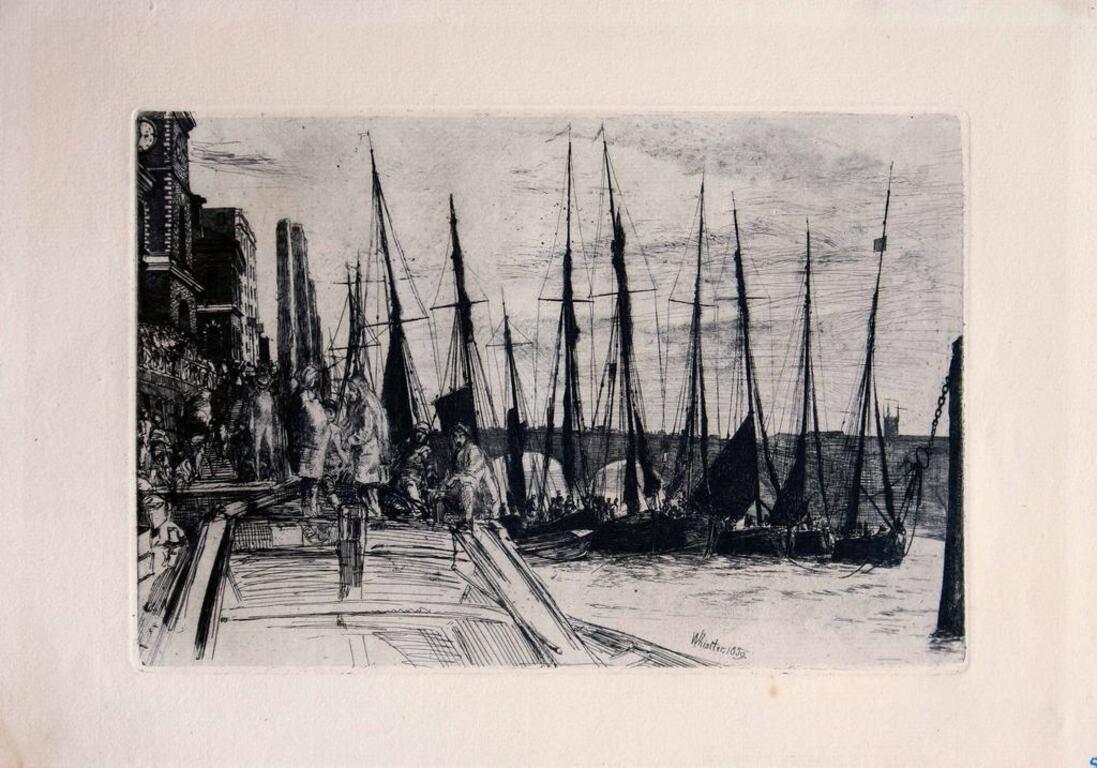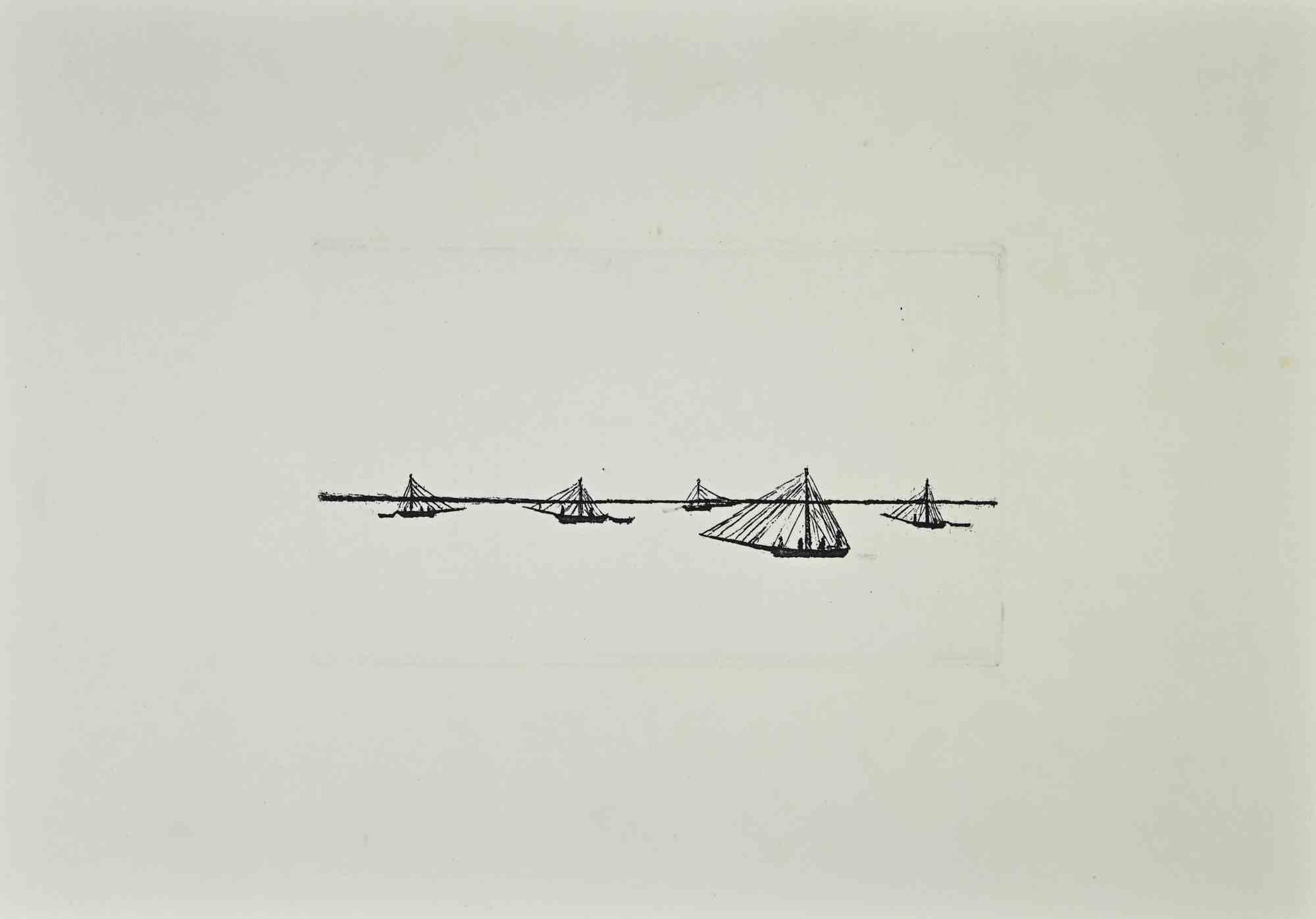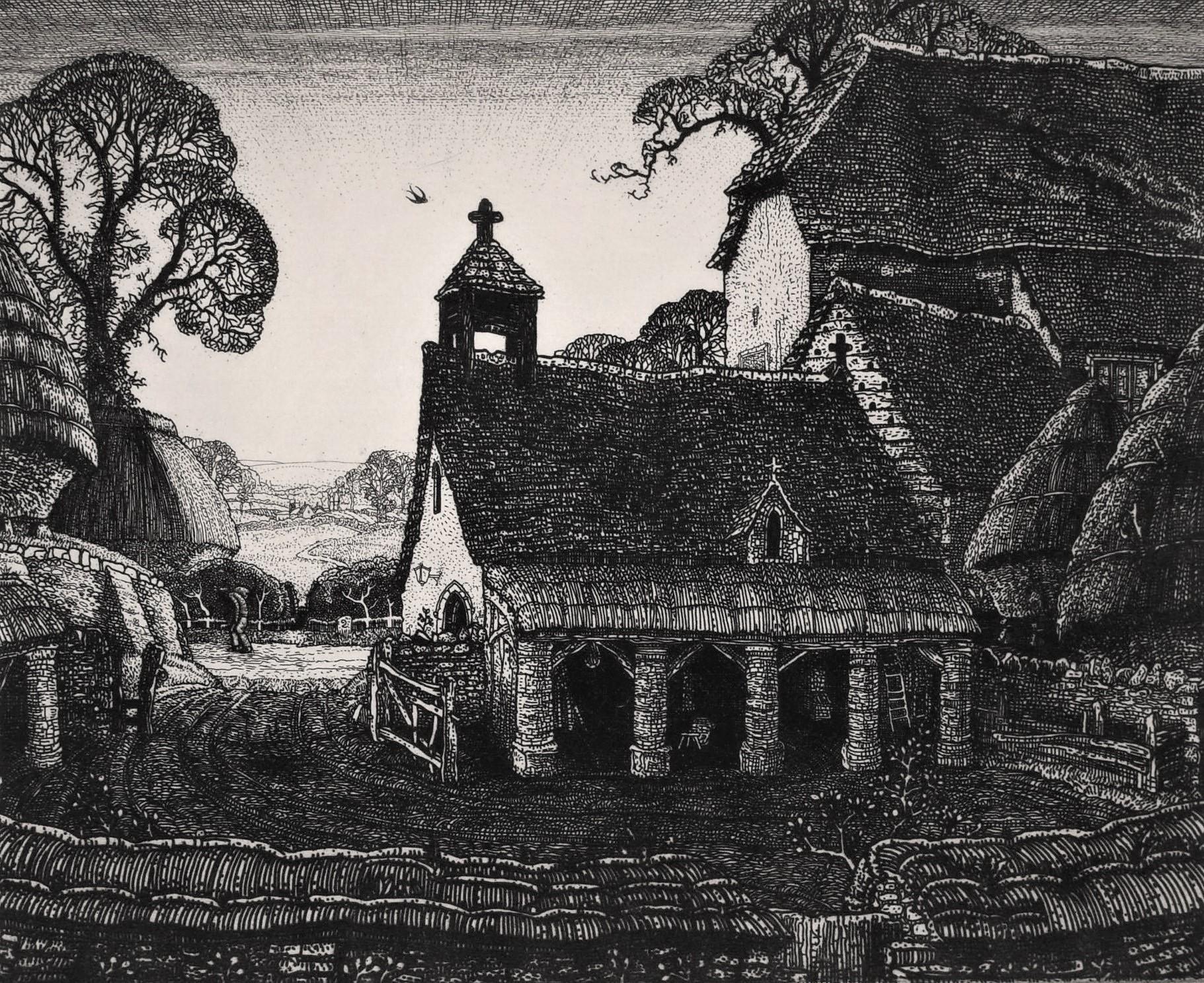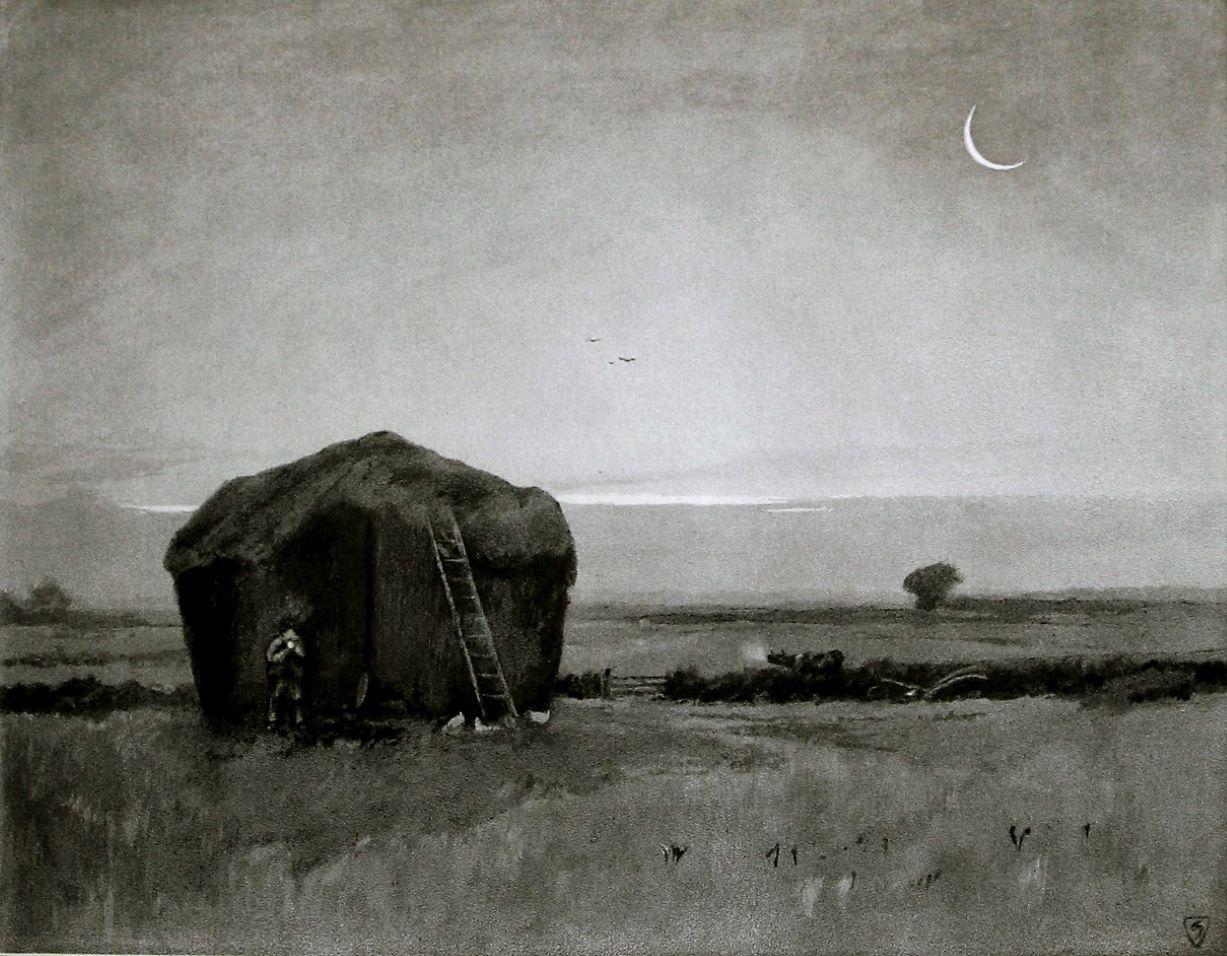Items Similar to The Thames from Waterloo.
Want more images or videos?
Request additional images or videos from the seller
1 of 4
William Walcot R. E. Hon. R. I. B. A.The Thames from Waterloo.1913
1913
About the Item
The Thames from Waterloo Bridge. 1913. Etching. Dickins 12. 3 3/4 x 7 1/16 (sheet 7 x 10 15/16). Edition 100. A fine proof with tonal wiping, printed on cream-wove paper. Signed in pencil.
Architectural draughtsman, etcher. Born in Lustdorf, near Odessa, Russia, to a British father and Russian mother. Traveled extensively with his family before studying architecture in St Petersburg, with further studies at Ecole des Beaux-Arts and Atelier Redan, Paris. Practiced architecture in Moscow and was co-designer of the Metropole Hotel, in 1898. Moved to London in 1907 and was employed as an architectural perspectivist. After a sponsored visit to Rome and Venice he had a solo exhibit at the Fine Art Society, 1912, 'Watercolours of London and Venice'; followed by a further four shows. He also exhibited at the Royal Academy, Royal Society of British Artists, Royal Society of Painter-Etchers..., and Connell & Sons. His etchings were published in London by H C Dickens,1913-24, and a folio of his work 'Architectural watercolors and etchings of William Walcot' was published, in 1919. Elected RE, 1920; FRIBA, 1922; Associate British School at Rome. A foremost architectural draughtsman, he worked from studios in London, Oxford and Rome.
The complete set of The Arteries of Great Britain includes: The Thames, The Tyne, The Forth, The Clyde, The Mersey. Signed in pencil .Housed in a 16 x 20 inch mat suitable for framing.
Opened in 1890, the Forth Bridge is a Scottish icon that is recognised the world over as the most famous of cantilever designs. The world's first major steel structure, the Forth Bridge represents a key milestone in the history of modern railway civil engineering and still holds the record as the world’s longest cantilever bridge.
A full-scale restoration project to return the bridge to its original construction condition was completed in 2012.
In July 2015, UNESCO inscribed the Forth Bridge as the sixth World Heritage site in Scotland.
Working as a painter and printmaker, William Walcot became the most celebrated architectural artist in England during the 1920s and 30s.
Settling in London in 1907, Walcot was first employed as a draughtsman to the architect Eustace Frere. He soon became a freelance draughtsman, producing presentation drawings for a number of leading architects to show their clients and to exhibit at the Royal Academy. His treatment of these drawings as works of art rather than technical exercises led to commissions from the Fine Art Society to visit Rome and Venice, and he held a total of eight solo shows with that dealer (1908-28). He also showed watercolours and etchings with leading exhibiting societies, and was elected to the membership of the Royal Society of Painter-Etchers and Engravers (ARE 1918, RE 1920) and the Royal Society of British Artists (1913). He was additionally a Fellow of the Royal Institute of British Architects (1922) and an associate of the British School in Rome. Steeped in the culture and architecture of antiquity, he designed and illustrated luxury editions of Salammbô (1926) and Hérodias (1928) by Gustave Flaubert for Les Editions d’Art Devambez.
- Creator:William Walcot R. E. Hon. R. I. B. A. (1874 - 1943, British)
- Creation Year:1913
- Dimensions:Height: 3.75 in (9.53 cm)Width: 7.07 in (17.96 cm)
- Medium:
- Movement & Style:
- Period:
- Condition:
- Gallery Location:Storrs, CT
- Reference Number:1stDibs: LU335211565792
William Walcot R. E. Hon. R. I. B. A.
When he was seventeen, William Walcot began to study architecture under Louis Benois at the Imperial Academy of Art in Saint Petersburg. He went to Paris where he continued his studies at the Ecole des Beaux-Arts and the Atelier Redon. He practiced as an architect briefly in Moscow, designing the Hotel Metropole in 1898. In 1907, Walcot settled in London where he was employed as a draughtsman by the South-African-born architect, Eustace Frere. In 1933, Walcot designed one London building, 61 St. James Street, but his main architectural activity was that of a freelance draughtsman. He produced drawings and etchings for architects to show their clients and to exhibit at the Royal Academy summer exhibitions. Throughout the 1920s and 1930s, Walcot was the most celebrated architectural draughtsman in England, enhancing the scale and drama of the buildings he depicted with his mastery of techniques including watercolor and gouache.
About the Seller
5.0
Recognized Seller
These prestigious sellers are industry leaders and represent the highest echelon for item quality and design.
Platinum Seller
These expertly vetted sellers are 1stDibs' most experienced sellers and are rated highest by our customers.
Established in 1977
1stDibs seller since 2016
702 sales on 1stDibs
Typical response time: 1 hour
Associations
International Fine Print Dealers Association
- ShippingRetrieving quote...Ships From: Storrs, CT
- Return PolicyA return for this item may be initiated within 3 days of delivery.
More From This SellerView All
- Alington in Wiltshire (The First Swallow).By Robin TannerLocated in Storrs, CTAlington in Wiltshire (The First Swallow). 1927. Etching. Garton 2.iv. 6 3/4 x 8 7/8 (sheet 10 1/2 x 13 1/2). Final state published by in an editon of 12 by Garton & Cooke in 1982 (Nicolson published an edition of 40 in 1927). In states iii and iv, the swallow of the title was removed. In state iv, the sky was re-etched and the cross-hatching was slightly finer. Signed in pencil. Garton writes, page 11: "The design was based on the Anglican chapel-of-ease is the farmyard of Bulisge at Allinston near Chippenham....The print was originally entitled The First Swallow, but the swallow was burnished out before the 1927 edition....Fifty years later new work was effected in the worn-out areas of the sky and distance to produce prints which, in his opinion, were better than those of the original edition." Robin Tanner was an English artist, etcher, and printmaker. He followed the visionary tradition of Samuel Palmer and English neo-romanticism. His etchings began following night-school classes at Goldsmiths College, London. He had been inspired by the major Samuel Palmer retrospective exhibition organized by Martin Hardie...Category
1920s Modern Landscape Prints
MaterialsEtching
- Twixt Dawn and DayBy Sir Frank ShortLocated in Storrs, CTTwixt Day and Dawn. 1919. Aquatint. Hardie catalog 165 state ii. Image 9 7/8 x 11 1/2 (sheet 13 9/16 x 16 7/8). A masterly inked impression produces subtle lighting variations throu...Category
Early 20th Century Modern Landscape Prints
MaterialsAquatint
- San Marco [Venice].By William Walcot R. E. Hon. R. I. B. A.Located in Storrs, CTWilliam Walcot. R.E., R.I.B.A. San Marco. Etching with drypoint and aquatint. Dickins 66, Harvey-Lee 91. 3 7/8 x 5 7/8 (sheet 9 1/4 x 12 1/8). Venice set, # 2. Edition 415. A rich impression printed on cream wove paper. Fold in the margin, well outside the image; otherwise good condition. Signed in pencil. Housed in a 16 x 20-inch archival mat. Soon after Walcot's arrival in England, the Fine Art Society sponsored a trip sent to Italy. This scene is one of four small drypoints that resulted from the artist’s stay in Venice. When he was seventeen, he began to study architecture under Louis Benois at the Imperial Academy of Art in Saint Petersburg. He went to Paris where he continued his studies at the Ecole des Beaux-Arts and the Atelier Redon. He practiced as an architect briefly in Moscow, designing the Hotel Metropole...Category
Early 20th Century Modern Landscape Prints
MaterialsDrypoint, Etching, Aquatint
- Chelsea Old Church, LondonBy William Walcot R. E. Hon. R. I. B. A.Located in Storrs, CTChelsea Old Church. 1924. Etching, drypoint, and aquatint. Dickins 94. 5 3/8 x 8 (sheet 8 1/2 x 9 3/4). Edition 100 for The Print Collector's Club. A fine proof with tonal wiping, printed on cream wove paper. Signed and dedicated "W.R. Button from W. Walcot London 1930" in pencil. Chelsea Old Church, also known as All Saints, is an Anglican church, on Old Church Street, Chelsea, London SW3, England, near Albert Bridge. It is the church for a parish in the Diocese of London, part of the Church of England. Inside the Grade I listed building, there is seating for 400 people. There is a memorial plaque to the author Henry James (1843–1916) who lived nearby on Cheyne Walk. To the west of the church is a small public garden containing a sculpture by Sir Jacob Epstein. When he was seventeen,William Walcot began to study architecture under Louis Benois at the Imperial Academy of Art in Saint Petersburg. He went to Paris where he continued his studies at the Ecole des Beaux-Arts and the Atelier Redon. He practiced as an architect briefly in Moscow, designing the Hotel Metropole...Category
Early 20th Century Modern Landscape Prints
MaterialsDrypoint, Etching, Aquatint
- Ludgate HillBy William Walcot R. E. Hon. R. I. B. A.Located in Storrs, CTLudgate Hill. 1921. Etching, aquatint, and drypoint. Dickins 69. 5 5/8 x 5 1/8 (sheet 13 5/8 x 9 3/4). A fine proof with plate tone, printed on 'J Wha[tman] cream wove paper. Edition of 275 for the UK and 125 for the US. Signed in pencil. Ludgate Hill is a street that runs west from St. Paul's Churchyard to Ludgate Circus (built in 1864), and from there becomes Fleet Street. The Ludgate Hill railway station, between Water Lane and New Bridge Street, is a station of the London, Chatham, and Dover Railway. It was closed before World War II and the railway bridge and viaduct between Holborn Viaduct and Blackfriars stations was demolished in 1990 to enable the construction of the City Thameslink railway station in a tunnel. This also involved the regrading of the slope of Ludgate Hill at the junction. About halfway up Ludgate Hill is St Martin, Ludgate church. This was physically joined to the Ludgate. When he was seventeen, William Walcot began to study architecture under Louis Benois at the Imperial Academy of Art in Saint Petersburg. He went to Paris where he continued his studies at the Ecole des Beaux-Arts and the Atelier Redon. He practiced as an architect briefly in Moscow, designing the Hotel...Category
Early 20th Century Modern Landscape Prints
MaterialsDrypoint, Etching, Aquatint
- Make Fast, Plate 2.By Arthur John Trevor BriscoeLocated in Storrs, CTMake Fast, plate 2. 1929. Etching. Laver catalog number 146; Hurst catalog number 258. Plate: 14 3/8 x 9 13/16 (sheet 17 5/8 x 11 3/4). Trial proof 2, before the edition or 75. Ill...Category
1920s Modern Landscape Prints
MaterialsDrypoint, Etching
You May Also Like
- Billingsgate - Etching by James Whistler - 1859By James Abbott McNeill WhistlerLocated in Roma, ITSigned and dated on plate. Eighth state of 8 (final state), after different works with drypoint, with margins. Published in 1878/79 on Japan paper in "The Portfolio". Matting includ...Category
1850s Modern Figurative Prints
MaterialsEtching
- The Pretty Boats - Etching by Giovanni Omiccioli - 1970sBy Giovanni OmiccioliLocated in Roma, ITThe pretty boats is an artwork realized by Giovanni Omiccioli (February 25, 1901 – March 1, 1975). Etching on cardboard. The artist wants to define a well-balanced composition, th...Category
1970s Modern Figurative Prints
MaterialsEtching
- The River By Meadow - Original Etching by Amadée Feau - 1921Located in Roma, ITThe River By Meadow is an original etching artwork on creamy-colored paper realized by French artist Amadée Feau (1872-1952) in 1921. Signed on the plate on the lower right and date...Category
1920s Modern Landscape Prints
MaterialsEtching
- Landscape with Trees - Original Etching by George-Henri Tribout - 1930sBy Georges-Henri TriboutLocated in Roma, ITLandscape with Trees is an original etching on paper artwork realized by Georges Henri Tribout. Good Conditions. Georges Henri Tribout (1884-19...Category
1930s Modern Landscape Prints
MaterialsEtching
- The River By Meadow - Original Etching by Amadée Feau - 1921Located in Roma, ITThe River By Meadow is an original etching artwork on creamy-colored paper realized by French artist Amadée Feau (1872-1952) in 1921. Signed on the plate on the lower right and date...Category
1920s Modern Landscape Prints
MaterialsEtching
- Radicofani - Original Etching by Bettino Craxi - 1980sBy Bettino CraxiLocated in Roma, ITRadicofani is an original contemporary artwork realized by Bettino Craxi in the first years of the 1980s. Original Etching. Very Good conditions. Beautiful etching depicting th...Category
1980s Modern Landscape Prints
MaterialsEtching
Recently Viewed
View AllMore Ways To Browse
1st Modern Dealer
Architectural Print Set Framed
House Of R And D
Antique Bridge Set
Russian School Icon
Set Of 4 Architectural Prints
Folio Society
Waterloo Antique
Set Of 4 Pencil Drawings
Antique Russian Icon Icons
Antique Russian Icon
Antique Railway Sign
Gustave Le Gray
Antique Technical Drawing Set
Waterloo Watercolor
Antique Hotel Key
Waterloo Bridge
Forth Bridge




![San Marco [Venice].](https://a.1stdibscdn.com/william-walcot-prints-works-on-paper-san-marco-venice-for-sale/a_3352/a_101504721690399029260/sanmarcoimage3_master.jpg)

